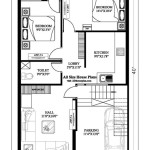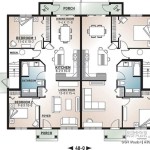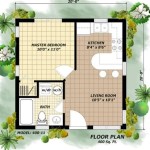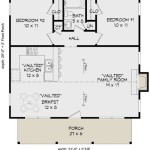How Much Does It Cost To Design a House Plan?
Designing a house plan is a crucial initial step in the construction of a new home or a major renovation project. The cost associated with this process can vary considerably, dependent on a multitude of factors. Understanding the potential expenses beforehand is vital for effective budgeting and ensuring the project aligns with financial constraints.
Several variables influence the overall cost of designing a house plan. These include the complexity of the design, the size of the house, the experience and location of the architect or designer, and the level of detail required in the plans. Each of these aspects plays a significant role in determining the final price.
The process of designing a house plan typically involves several stages. Initially, there's a consultation phase where the client outlines their needs and preferences. This is followed by preliminary design development, detailed design work, and finally, the creation of construction documents. Each of these phases contributes to the overall cost.
Factors Influencing the Cost of House Plan Design
Several factors contribute significantly to the overall cost of designing a house plan. Understanding these elements allows for a more informed approach when seeking design services and negotiating fees.
Size and Complexity: The square footage of the house is a primary determinant of the design cost. Larger homes naturally require more design time and more intricate detailing. The complexity of the design also plays a crucial role. A simple, rectangular house will generally be less expensive to design than a multi-story home with a complex roofline, custom features, or unique architectural elements. Features such as curved walls, numerous dormers, or complicated layouts will increase design time and, consequently, the cost.
Level of Detail: The level of detail required in the house plans impacts the overall cost. Basic plans may only include floor plans, elevations, and a site plan. More comprehensive plans may include detailed electrical layouts, plumbing schematics, structural engineering drawings, and specifications for finishes and materials. The more detailed the plans, the more time and expertise required, resulting in higher design fees. For instance, plans required for permitting and construction need to be extremely detailed to ensure compliance with local building codes and to provide clear instructions for the construction team.
Designer or Architect's Experience and Location: The experience and reputation of the architect or designer significantly affect their fees. Highly experienced and renowned architects typically charge more than less experienced designers. Their expertise ensures a higher quality of design and potentially fewer issues during the construction phase. Location also plays a role, as design fees tend to be higher in metropolitan areas with a higher cost of living. Furthermore, the demand for architectural services in a particular area can also influence pricing.
Customization and Modifications: Customized designs and frequent modifications to the plan will increase the design cost. If the client has specific requirements or desires significant changes to the initial design, the architect or designer will need to invest more time and effort in revising the plans. Therefore, it is beneficial to have a clear and detailed vision of the desired house design before engaging with a designer or architect to minimize the need for extensive modifications.
Additional Services: Additional services, such as 3D renderings, interior design, landscape design, or assistance with permit applications, will add to the overall cost. While these services are not always necessary, they can enhance the visualization of the final product and streamline the construction process. For example, 3D renderings can help visualize the house's appearance, while interior design services can help select finishes and fixtures. Assistance with permit applications can save time and ensure compliance with local regulations.
Methods of Pricing for House Plan Design
Architects and designers employ various pricing methods for house plan design, each with its advantages and disadvantages. Understanding these methods helps clients choose the most appropriate option for their project.
Percentage of Construction Cost: Some architects charge a percentage of the estimated construction cost. This method is common for full architectural services, where the architect is involved throughout the entire project, from design to construction administration. The percentage typically ranges from 5% to 15% of the total construction cost, depending on the complexity of the project and the architect's experience. While this method can be transparent in linking design fees to the overall project budget, it can also be challenging to estimate the construction cost accurately at the outset, potentially leading to unforeseen expenses.
Hourly Rate: Charging an hourly rate is another common method. The hourly rate can vary significantly based on the architect's experience, location, and the complexity of the project. Hourly rates can range from $75 to $250 or more. This method is suitable for smaller projects or when the scope of work is not well-defined. It allows for flexibility and accurate billing based on the actual time spent on the project. However, it can be difficult to estimate the total cost upfront, and clients need to carefully monitor the hours billed to stay within budget.
Fixed Fee: A fixed fee, also known as a lump sum, is a predetermined amount agreed upon for the entire design project. This method provides cost certainty and allows clients to budget effectively. It is suitable for projects with a well-defined scope and clear deliverables. However, fixed fees may be less flexible if unexpected issues arise or if the client requests significant changes to the design. Architects typically estimate the total time required for the project and factor in potential contingencies when setting the fixed fee.
Cost Per Square Foot: Some designers and architects charge a cost per square foot for their services. This method is straightforward and easy to understand. The cost per square foot can vary from $2 to $10 or more, depending on the complexity of the design and the designer's experience. This method is suitable for projects with a relatively standard design and a clear understanding of the house's square footage. However, it may not accurately reflect the complexity of certain design elements or the level of customization required.
Combination of Methods: In some cases, architects and designers may use a combination of pricing methods. For example, they may charge an hourly rate for initial consultations and preliminary design work and then switch to a fixed fee for the detailed design and construction documents. This approach allows for flexibility and transparency in billing while providing cost certainty for the major phases of the project. It is important to discuss the pricing method in detail with the architect or designer and to ensure that it is clearly outlined in the contract.
Ways to Reduce House Plan Design Costs
While designing a house plan can be a significant investment, several strategies can help reduce the overall cost without compromising the quality of the design.
Clear and Detailed Requirements: Providing the architect or designer with clear and detailed requirements upfront can save time and reduce the need for revisions. Having a clear vision of the desired house design, including the layout, style, and features, allows the designer to create a plan that aligns with the client's needs from the outset. This reduces the likelihood of costly modifications later in the design process.
Using Stock Plans as a Starting Point: Consider using stock plans as a starting point for the design. Stock plans are pre-designed house plans that can be purchased for a fraction of the cost of a custom design. While stock plans may not perfectly match the client's requirements, they can be modified to create a semi-custom design that meets their needs. This approach can significantly reduce design fees while still allowing for some degree of customization.
Phased Design Approach: Consider a phased design approach, where the design is developed in stages. This allows the client to review and approve each phase before proceeding to the next, reducing the risk of significant changes later in the process. For example, the client may start with a preliminary design, then move to detailed design, and finally to construction documents. This approach also allows for better cost control and budgeting.
Choosing a Less Complex Design: Opting for a simpler and less complex design can significantly reduce design costs. A rectangular house with a simple roofline will generally be less expensive to design than a house with a complex layout, multiple stories, or intricate architectural details. Eliminating unnecessary features and streamlining the design can save time and money without sacrificing functionality or aesthetics.
Obtaining Multiple Quotes: Obtaining quotes from multiple architects or designers is crucial to ensure competitive pricing. Comparing quotes allows clients to assess the market rates for design services and to choose the best option that fits their budget. It is important to consider not only the price but also the experience, qualifications, and portfolio of each designer or architect. Discussing the project in detail with each candidate and asking questions about their pricing method and process can help make an informed decision.
Minimizing Revisions: Minimizing revisions to the design can also help reduce costs. Frequent changes to the plan can significantly increase design time and, consequently, the cost. Therefore, it is beneficial to review the design carefully at each stage and to provide feedback promptly to avoid delays and unnecessary revisions.
In summary, the cost to design a house plan is influenced by a complex interplay of factors. By understanding these elements and employing cost-saving strategies, clients can effectively manage their budgets while achieving their desired home design. Careful planning, clear communication, and thorough research are essential for a successful and cost-effective house plan design process.

How Much Does A Floor Plan Cost

How Much Do 3d House Plans Cost Faqs Answered Cedreo

How Much Do 3d House Plans Cost Faqs Answered Cedreo

3d Floor Plan Cost

Get The Lowdown On Cost To Build Estimates Houseplans Blog Com

Est House Plans To Build Simple With Style Blog Eplans Com
How Much It Should Cost To Get Home Elevation Floor Plan Designs For Double Story 1000 Sq Ft 20x40 Small Design Quora

How Much It Should Cost To Get Home Elevation Floor Plan Designs For Double Story 2400 Sq Ft Small Design

How Much Do House Plans Cost Drummond

Custom Floor Plan Cost 2d And 3d Plans








